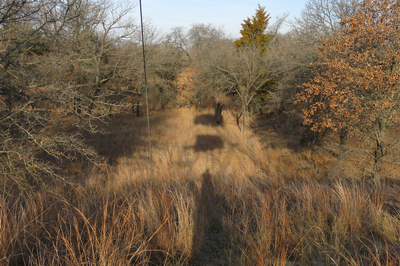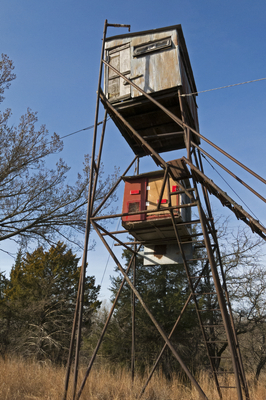Barn Owl nesting box
Mar 19, 2018 20:19:23 #
The photo of the red barn encouraged me to write this narrative. In Kansas, as old barns are falling down or being torn down, there are fewer places for Barn Owls to nest. One of my projects over the years, as been to work with qualified university ornithology professors in recording successful nests and fledging numbers from owl nesting boxes. The boxes are attached and support on deer hunting towers. The lower red structure is the owl nesting box On the upside for farmers, Barn Owls are "rodent killing machines".


Mar 19, 2018 20:42:06 #
Barn Owl wrote:
The photo of the red barn encouraged me to write t... (show quote)
Interesting!
Before Europeans came to north America and started building Barn Owls places to live...., were historically did barn owls nest???
In tree hollows? In Small caves? Were they communal? Is their habitat now gone? I've seen several barn owls in one barn.
SS
Mar 20, 2018 00:40:35 #
I've seen houses (or whatever you want to call them) for marsh wrens, herons, owls and miscellaneous other birds. Now burrowing owls are organizing to campaign for the government/public burrows to which they are entitled. snakes want homes with Den Mothers. SALT LICKS UNLIMITED TO SLURP (SLUTS)!
🤪🤣😂😖🤔😝
🤪🤣😂😖🤔😝
Mar 20, 2018 09:00:26 #
Has this been a good substitute for the owls? Thanks for posting this!
Mar 20, 2018 09:12:46 #
MJKilpatrick
Loc: Cape May, NJ
Hi Folks,
Of course the landscape since settlers first came to the Americas has changed and so to did the habitats of the American Barn Owl. Historically, as is the case now, it is a secondary cavity nesting bird (secondary means if does not create the cavity but uses an existing cavity, a woodpecker would be a primary cavity nesting bird as it both creates and occupies the cavity). It's primary nesting spot was in larger cavities in old trees but was also found nesting in caves, cavities in rock and boulder fields, and was not a stranger to nesting on the ground. But for the most parts it was and still is a forest cavity nesting bird of the transitional forest zones bordering open grasslands (interior and coastal grasslands like prairies, marshes, etc.)
Two things, though I am sure there were many other pressures on it, changed........the great degree of tree cutting, especially the easily accessible transition forests on the edges........and the transition of the grassland areas (upland and marshlands) to agriculture which cleared and disrupted the natural succession character of these habitats. As their historic habitat waned, human structures appeared.........and they transitioned to what we associate them to be now. In many historic narratives the are referred to the Monk Faced Owl, White Owl, or the Golden Owl.............the reference to Barn Owl evolved later but as early as the late 1700's and early 1800's, the name Barn Owl was used.....an indication that their transition to human structure was something they took too earlier rather than more modern times. As reference, Alexander Wilson, whose book was published just after the turn of 1800, refers to it as a Barn Owl, it appears on plate 50 and can be accessed through the Ohio Wesleyan University on-line library if you would like to see it (the rendering is at the top of the plate and the ID is written along the very bottom of the plate for each bird that appears....the Barn Owl is #2). It can be accessed here : http://cdm15963.contentdm.oclc.org/cdm/compoundobject/collection/p15963coll48/id/1044
I also attached a link to an account of the owl from Southeastern Pennsylvania by J. Harris Reed (www.jstor.org/stable/4068471), where he talks about some of these habitat changes. His discussion talks about the area along the Delaware River where the Philadelphia Airport and the John Heinz National Wildlife Refuge now sits. It is one of the later accounts of the owl where it still had used the old transitional forests and cavities to nest but they were destroyed as development as human use infringed. It gives a good snap shot of what the owl was and now is as to its nesting habits.
Now, the owl faces another transition.........most of that old human structure is disappearing and the owl is faced with not only its historic nesting habitat mostly gone but also its adapted habitat. Thus the emergence of the conservation efforts with the erection of nesting boxes. The owl's numbers have been decreasing.
So maybe this will give some historic perspective to the owl..........its story is not much different than other birds and animals.
With My Best,
Of course the landscape since settlers first came to the Americas has changed and so to did the habitats of the American Barn Owl. Historically, as is the case now, it is a secondary cavity nesting bird (secondary means if does not create the cavity but uses an existing cavity, a woodpecker would be a primary cavity nesting bird as it both creates and occupies the cavity). It's primary nesting spot was in larger cavities in old trees but was also found nesting in caves, cavities in rock and boulder fields, and was not a stranger to nesting on the ground. But for the most parts it was and still is a forest cavity nesting bird of the transitional forest zones bordering open grasslands (interior and coastal grasslands like prairies, marshes, etc.)
Two things, though I am sure there were many other pressures on it, changed........the great degree of tree cutting, especially the easily accessible transition forests on the edges........and the transition of the grassland areas (upland and marshlands) to agriculture which cleared and disrupted the natural succession character of these habitats. As their historic habitat waned, human structures appeared.........and they transitioned to what we associate them to be now. In many historic narratives the are referred to the Monk Faced Owl, White Owl, or the Golden Owl.............the reference to Barn Owl evolved later but as early as the late 1700's and early 1800's, the name Barn Owl was used.....an indication that their transition to human structure was something they took too earlier rather than more modern times. As reference, Alexander Wilson, whose book was published just after the turn of 1800, refers to it as a Barn Owl, it appears on plate 50 and can be accessed through the Ohio Wesleyan University on-line library if you would like to see it (the rendering is at the top of the plate and the ID is written along the very bottom of the plate for each bird that appears....the Barn Owl is #2). It can be accessed here : http://cdm15963.contentdm.oclc.org/cdm/compoundobject/collection/p15963coll48/id/1044
I also attached a link to an account of the owl from Southeastern Pennsylvania by J. Harris Reed (www.jstor.org/stable/4068471), where he talks about some of these habitat changes. His discussion talks about the area along the Delaware River where the Philadelphia Airport and the John Heinz National Wildlife Refuge now sits. It is one of the later accounts of the owl where it still had used the old transitional forests and cavities to nest but they were destroyed as development as human use infringed. It gives a good snap shot of what the owl was and now is as to its nesting habits.
Now, the owl faces another transition.........most of that old human structure is disappearing and the owl is faced with not only its historic nesting habitat mostly gone but also its adapted habitat. Thus the emergence of the conservation efforts with the erection of nesting boxes. The owl's numbers have been decreasing.
So maybe this will give some historic perspective to the owl..........its story is not much different than other birds and animals.
With My Best,
Mar 22, 2018 19:58:25 #
Nice photos Barn Owl!
That sounds like a great symbiotic relationship between the owls and the farmers.
That sounds like a great symbiotic relationship between the owls and the farmers.
Barn Owl wrote:
The photo of the red barn encouraged me to write t... (show quote)
Mar 22, 2018 20:31:45 #
If you want to reply, then register here. Registration is free and your account is created instantly, so you can post right away.



